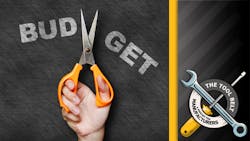Podcast: How to cut waste from your reliability and maintenance program
Joe Kuhn, CMRP, former plant manager, engineer, and global reliability consultant, is now president of Lean Driven Reliability LLC. He is the author of the book “Zero to Hero: How to Jumpstart Your Reliability Journey Given Today’s Business Challenges” and the creator of the Joe Kuhn YouTube Channel, which offers content on starting your reliability journey and achieving financial independence. In our new podcast series, Ask a Plant Manager, Joe considers a commonplace scenario facing the industry and offers his advice, as well as actions that you can take to get on track tomorrow. This episode offers insight on how to make necessary budget cuts.
PS: So my question for you today has to do with finances and budgeting. It’s often the linchpin of many business decisions, whether it should be or not. So for this facility, our maintenance and reliability department needs to cut the budget by 10%. How do we evaluate what and where to cut? Where do we start? Or where and how do most facilities find waste to cut in their reliability and maintenance programs?
JK: Yeah, it’s a great question and I would be surprised if any maintenance organization has not faced this question. So the first thing I like to understand is why the request for 10% reduction? Sometimes it's business critical; okay, got it. Sometimes it's just to motivate people into improvement. The company is feeling stagnant, not making improvement the last few years, and it's just a motivational tool to say, ‘we need to improve.’ Okay, and I think it's important, which one of those that it is.
I'll address it from a standpoint of: the business needs this, you got to cut 10%? What would I do? First thing I would do is I'd get the leadership together from the maintenance department, maybe your reliability engineers, if you have any engineering people in your plant, a couple thought leaders, innovators, maybe a lead planner or planner supervisor, just that group of people and say, ‘Okay, guys, 10%. Okay, let's first have a review of where our money's being spent.’ Ten percent of a million dollars means you need $100,000. So we're looking for $100,000. You’ve to look at where the big expenditures are; for a lot of people, it begins with labor. There are also some materials like motors, gearboxes, chains, things like that. Then, there's also supplies. Those are kind of the big three. Some plants have a lot of contractor support.
So look at each a slice of the pie and say, ‘Okay, this is where based on our experience, our collective decision, we think it's in materials, and we think it's in contractors, okay, that's what we want to do.’ That's the start. Now, if you listen to me at all or read any of my stuff, I say supplement that with observation. So let's go out, let's deep dive into our materials. Let's deep dive into our contractor spin. What's that contract look like? Are there other options out there? That's where I would go.
If it's labor, look at overtime. One of the premium things that you'll find in observation is say, we're working 15% overtime. Well, who approves that overtime? And did we need to work it? Very often in plants overtime is spent on things that are not critical. ‘Hey, production said we need to repair this gearbox system.’ But do they actually need that equipment? Or do they have a workaround for that equipment and you can work it on straight time tomorrow or straight time the day after that? So really having an approval process for overtime, quite often reduces the overtime need 20, 40 or up to 50%. So that's a good step.
Another thing that I like doing, specifically around contractor spend or external services coming in, is pull them in. If it's somebody that erects scaffolding for you to do jobs, just as an example. We did a lot of that, but pull in that scaffolding supplier and say, ‘Hey, we need to cut cost by 10%. What are your ideas, anything that you can do increase risk or something like that to change the way we work with you? What are we doing as a company? When I send you a requested erect scaffolding, what makes us difficult to deal with?’ And I have a good example that one. This company needed a place to store all its scaffolding, and we made them come in and unload it and erect it and then get out within a certain time window. Well, we said, why are we doing that? Why don't we let him store the equipment here? And they reduced our cost quite a bit.
So my main message is once you identify four or five levers, it could be contractor spend, could be overtime, could be materials, decide how you're going to observe, go out and see. An example would be say you have a high motor cost. Ten percent of your total expenditure is on motors. Well, go to the people that repair your motors and go to the people that lube the motors and say, ‘Okay, what are we doing that's causing some of these failures?’ And you may find that you can prevent 25 to 30% of those failures by going into the details and saying, ‘How are we doing maintenance? I know, we have a checkmark on a PM that said we did the PM, but are we doing the PM?’ Talk to the person doing the PM? What did he or she see? How can we improve that? Go and see. Always 100% of the plants that I've worked with, and 100% of the plants that I've been in myself, 100% of the time, observation changes the actions I was going to take. And most of the time, those actions can really be implemented for free, and in under 30 days.
So that's what I would do. I get the troops together, get the people together. Let's brainstorm; let's come up with four or five leverage points and decide how we're going to see reality with observation. The other thing I would do is I'd add in if you have a large external spend, like with vendors doing things for you, or contractors coming in, sit down with them, and see what they could do for you, specifically ask the question, how can we be a better customer of your services that can turn into a lower cost? Those things have worked for me very well in the past.
About the Author
Joe Kuhn
CMRP
Joe Kuhn, CMRP, former plant manager, engineer, and global reliability consultant, is now president of Lean Driven Reliability LLC. He is the author of the book “Zero to Hero: How to Jumpstart Your Reliability Journey Given Today’s Business Challenges” and the creator of the Joe Kuhn YouTube Channel, which offers content on creating a reliability culture as well as financial independence to help you retire early. Contact Joe Kuhn at [email protected].

Anna Townshend
managing editor
Anna Townshend has been a journalist and editor for almost 20 years. She joined Control Design and Plant Services as managing editor in June 2020. Previously, for more than 10 years, she was the editor of Marina Dock Age and International Dredging Review. In addition to writing and editing thousands of articles in her career, she has been an active speaker on industry panels and presentations, as well as host for the Tool Belt and Control Intelligence podcasts. Email her at [email protected].

